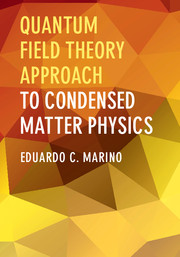Quantum Field Theory Approach to Condensed Matter Physics
A balanced combination of introductory and advanced topics provides a new and unique perspective on the quantum field theory approach to condensed matter physics. Beginning with the basics of these subjects, such as static and vibrating lattices, independent and interacting electrons, the functional formulation for fields and different generating functionals and their roles, this book presents a unified viewpoint illustrating the connections and relationships among various physical concepts and mechanisms. Advanced and newer topics bring the book up to date with current developments and include sections on cuprate and pnictide superconductors, graphene, Weyl semimetals, transition metal dichalcogenides and topological insulators. Finally, well-known subjects such as the quantum Hall effect, superconductivity, Mott and Anderson insulators, and the Anderson–Higgs mechanism are examined within a unifying QFT-CMP approach. Presenting new insights on traditional topics, this text allows graduate students and researchers to master the proper theoretical tools required in a variety of condensed matter physics systems.
- Covers several advanced topics which have not yet been covered in current literature in the field and brings readers up to date with the latest thinking
- The self-contained approach covering both basics and more advanced topics enables the reader to gain a full understanding of the field from a single source
- The book can be used in various ways for teaching as the first chapters serve as an introductory course in CMP and QFT, while the later sections move into the details of a wide variety of condensed matter systems
Reviews & endorsements
'Quantum field theory and condensed matter physics have mutually benefited from the progress in their respective areas. Recently some authors have been working to provide a unified view of these fields, both conceptually and in their technical aspects. Eduardo C. Marino's book is an important step in this direction and it is bold in its outlook as it deals with problems that have no consensual solution yet in the scientific community. In these chapters Marino is especially inspired as he guides the reader firmly through the challenges presented by these problems. His approach leads to a powerful grasp of mathematical tools and a solid knowledge of the most actual problems in condensed matter physics.' Mucio Amado Continentino, Centro Brasileiro de Pesquisas Físicas, Brazil
'This book explains how one can use Quantum Field Theory (QFT) to analyze Condensed Matter Physics and as a result it comprises three main parts which are respectively (I) condensed matter physics, (II) quantum field theory and (III) quantum field theory approach in condensed matter systems. The book is bulky, but if you have the basis, only the basis, background of the mathematical machinery of quantum mechanics, you will read it easily. … The number of topics so considered is rather large enough to include, for instance, Fermi liquids and Anderson insulators, polarons, polyacetylene, quantum magnets in 1D and in 2D, spin-fermion system, spin glass, superfluidity, superconductivity, pnictides,graphene, silicenes, insulators quantum, quantum computation. … I used to give these books-for-review as a gift to the library of my university, but I decided to keep the present one for my own personal library.' Guy Jumarie, Zentralblatt MATH
'This book provides an excellent overview of the state of the art of quantum field theory (QFT) applications to condensed-matter physics (CMP). … I would keenly recommend this to advanced graduate students and researchers in the field, who will find, in part three, plenty of hot topics that are very well explained and accompanied by complete references.' Rogelio Palomo, CERN Courier
'Students in particular would welcome seeing how the 'new' formalism can be matched with an 'old' one … this is a useful book to have in one's library.' Malte Henkel, Acta Crystallographica Section A
Product details
September 2017Adobe eBook Reader
9781108514811
0 pages
108 b/w illus.
This ISBN is for an eBook version which is distributed on our behalf by a third party.
Table of Contents
- Preface
- Part I. Condensed Matter Physics:
- 1. Independent electrons and static crystals
- 2. Vibrating crystals
- 3. Interacting electrons
- 4. Interactions in action
- Part II. Quantum Field Theory:
- 5. Functional formulation of quantum field theory
- 6. Quantum fields in action
- 7. Symmetries: explicit or secret
- 8. Classical topological excitations
- 9. Quantum topological excitations
- 10. Duality, bosonization and generalized statistics
- 11. Statistical transmutation
- 12. Pseudo quantum electrodynamics
- Part III. Quantum Field Theory Approach to Condensed Matter Systems:
- 13. Quantum field theory methods in condensed matter
- 14. Metals, Fermi liquids, Mott and Anderson insulators
- 15. The dynamics of polarons
- 16. Polyacetylene
- 17. The Kondo effect
- 18. Quantum magnets in 1D: Fermionization, bosonization, Coulomb gases and 'all that'
- 19. Quantum magnets in 2D: nonlinear sigma model, CP1 and 'all that'
- 20. The spin-fermion system: a quantum field theory approach
- 21. The spin glass
- 22. Quantum field theory approach to superfluidity
- 23. Quantum field theory approach to superconductivity
- 24. The cuprate high-temperature superconductors
- 25. The pnictides: iron based superconductors
- 26. The quantum Hall effect
- 27. Graphene
- 28. Silicene and transition metal dichalcogenides
- 29. Topological insulators
- 30. Non-abelian statistics and quantum computation
- References
- Index.



